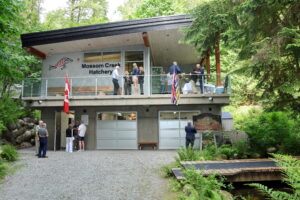A group of Mossom Creek volunteers spent Thursday morning (June 25th) clipping very tiny adipose fins from the hatchery’s coho fingerlings. It is one of those tasks that requires very close attention, yet the rewards are many. For the volunteers, it is an opportunity to support the hatchery’s work, socialize with other people, and engage with the fish. For Mossom Creek Hatchery, as well as Fisheries and Oceans Canada (DFO), the implications of clipping coho fins are significant.
DFO strongly advises hatcheries to clip the fins for several reasons. For instance, sport fishers know that ‘clipped’ coho may be kept (Wild salmon must be released). More importantly, the clipped fins allow hatcheries to monitor their success rate (numbers of returning hatchery vs. wild coho). This data is also critical to DFO’s mission of maintaining and strengthening the diversity of salmon stock across BC. DFO Community Advisor Sandy Hollick-Kenyon reports, “Salmon from different stream ecosystems can actually be differentiated by their DNA. This diversity helps ensure the overall population’s ability to withstand diseases and ecological changes. Over time the returning fish will evolve specifically to this stream’s ecosystem. Our goal is to have no more than 50% of a stream’s salmon be hatchery raised, so that they don’t overrun the wild salmon population. When the hatchery’s coho are marked with the clipped fins, it enables us to monitor the success of the wild salmon’s population as well as the hatchery’s success”.
So How Do You Clip a Coho’s Fin..?
The process involves very, very careful anesthetizing of the fish by DFO Fisheries Technician Scott Ducharme. “My objective is to for the fish to become quiet and sleepy within a minute and then to recover within a minute.” It’s a very fine line, so Scott doses the fingerlings in small batches, just enough for the volunteers to clip them within the short time frame (A wiggly fish is very difficult to handle!). Volunteers stand around a table rimmed with a trough of shallow water. Each volunteer takes a fingerling, carefully clips the adipose fin with surgical scissors, and places the fish into the trough where it makes its way to a bucket and is quickly carried back to the rearing tub for recovery. These are good-sized fish and very healthy, so their prognosis is good.

The coho will stay at the hatchery until next spring, mirroring the cycle of coho in the wild. Naturally, coho are an upstream salmon, staying in fresh water for about a year before migrating to the ocean. Then in two and a half years, the Hatchery should see the return of some of this group – the first coho to be raised in the new building.
A big thank you to the Mossom Creek volunteers for their careful work in clipping some 3,904 fingerlings. (Pam Blackman, Ron Fisher, Damian Regan, Kyle Pilon, Patty Anderson, Coleen Hackinen, Kevin Ryan, Paulette Strim, Eric Olsen, Dave Bennie, Cory Bettles, Jennifer Madoc-Jones and Caroline as well as Brian Wormald and Kevin Niehaus from Noons Creek Hatchery, assisted by Hatchery Manager Neil Laffra, and Director Ruth Foster).


